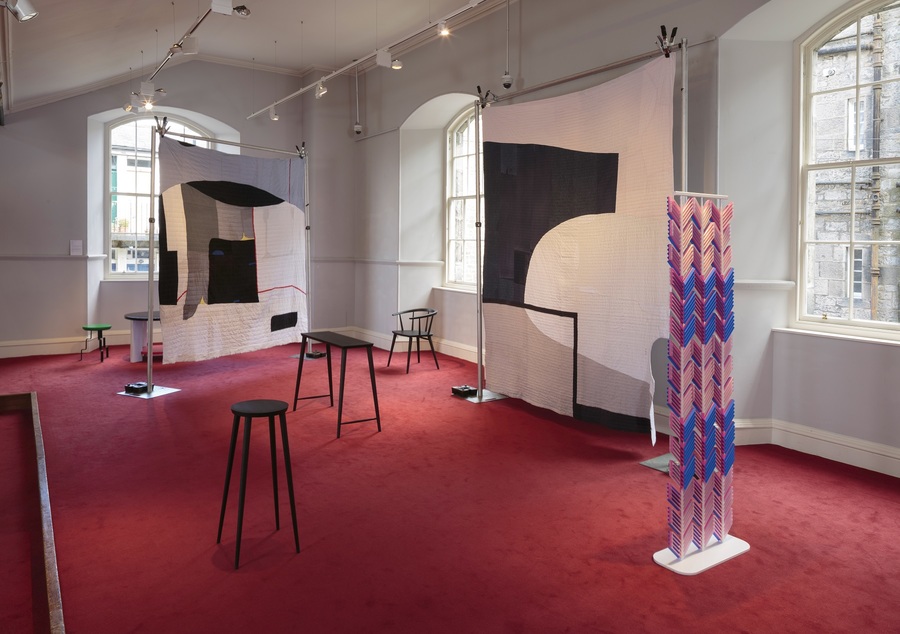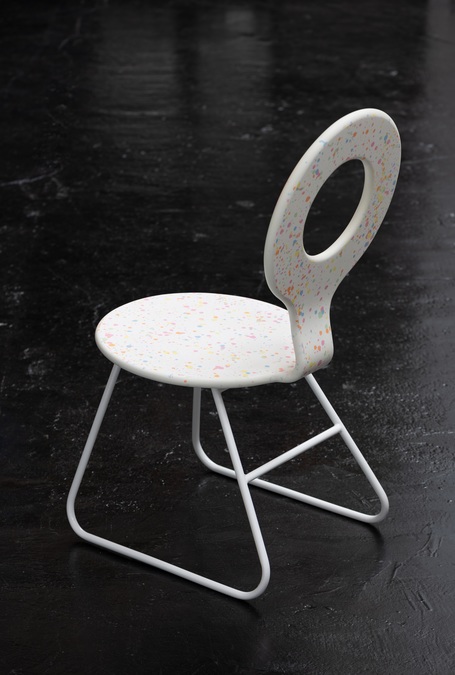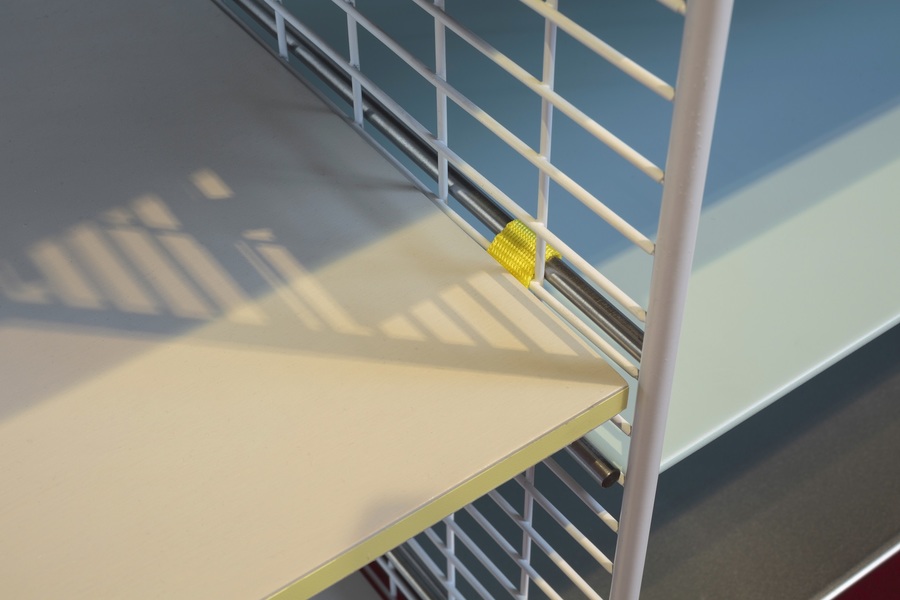Built to last: Design Exhibition Scotland
Local Heroes select five practitioners from Design Exhibition Scotland who explore the ways in which functional objects enhance the way we live our lives and address issues around sustainability, materials and process
Design Exhibition Scotland (DES) wants to "turn up the volume on robustly contemporary and exploratory design." Founded in 2018, the latest incarnation was exhibited in June and featured furniture and accessories by 33 designers and artists. Founder Susanna Beaumont says, “I want to give impetus to long-fostered ideas and introduce a wide audience to the energetic brilliance of some of the many contemporary designers working today across Scotland.”
Becky Šik’s minty fresh modular shelving piece Ama is made using powder coated, lacquered and stainless steel, with stained and oiled birch plywood. Inspired by modular units through the ages, particularly mid-century German and Scandinavian design, she decided to experiment with modular shelving. “I have a fascination with repurposing materials," she says. "The welded mesh offers transparency, lightness, geometry and functionality to create adjustable shelving units that are light and open. The hanging mechanisms offer a playful solution to height adjustability and add splashes of colour.”
Šik tells us: “There are lots of important conversations to be had about what makes truly sustainable design and what new materials can contribute to well-made items with a good lifespan. Eco, environmental, sustainable etc are all words we use a lot but I think it is extremely difficult to make work economically viable while truly limiting its environmental impact, whether that is where the material comes from or the production processes used versus its lifespan and longevity. Exhibitions that profile innovative or beautiful, well-made items can raise the profile of design to a point where Scotland can take seriously the need for proper investment in new materials development and tooling, and in supporting small businesses and ideas to flourish.”
Daniel Brophy of Black Box Furniture (@blackboxfurniture) presented three pieces made using ebonised oak where the principles of high quality stand for well-built and considered design where there is true sustainability in longevity. Heavily inspired by the traditional joinery techniques and methods used in Windsor chair making, Brophy has taken the shapes, lines and elements from mid-century modern styling and refined these over many months to produce an aesthetically pleasing, functional and comfortable heirloom piece.
“Much of the work produced by artists and designers holds both a deep emotional attachment and an enormous amount of time and effort," says Brophy. "Being able to experience works first hand and search for the finer details and design elements allows the public to become much closer to the designer and gain an understanding of their design philosophy.”
Glasgow’s Kev Pollock (@kevpollock) has taken childhood memories of playing with and picking the blue foam from his mother’s upholstering projects to inform his highly original stainless steel and PU foam table and stools, with contrast between the baby blue foam and the clean, sharp lines of the stainless steel legs. “Mum was a dressmaker and dabbled in upholstering so we had lots lying around.” For the past two years he has been renovating a disused space and setting up a new workshop in Govan where his practice continues to explore the boundaries between sculpture and furniture.
“I loved the opportunity to develop these structures and materials into a more viable product yet still using materials in a way not normally associated with furniture,” – Pollock believes that its important for audiences to experience objects first-hand and explore the finer details rather than only consuming online. “Public exhibitions allow audiences to realise that local design is actually quite easily accessible and something to be encouraged and embraced, particularly in today’s world where low-cost furniture has almost become disposable.”
Camille Arnould Walachowski is the founder of Studio Walac (@studio.walac). Her Room for Irregularities series incorporates a large mirror and chair made using hand blackened steel, with grey and silver mirrors. “The idea for the mirrors emerged from driving along Loch Lomond at night, under a full moon. From this calm body of black water with silver gleams and dancing shadows. The night was a kind of anti-Narcissus where you can only guess the shapes of a body reflecting in the water. The topographic fragmentation of the land with all these lochs can be found in the three mirrors of the collection. They make room for irregularities and ‘connect the islands of self’." One of the biggest impacts for her of being invited to exhibit with DES was seeing the furniture community emerge. “When we were all isolated across Scotland, it turned out many of our neighbours were making furniture as well. We can start a discussion now, push it and challenge its edges.”
In Kate Morgan’s A Bench for The Universal Holding Device she explores ideas of functionality, gesture, and the decorative. Integral to the bench is Morgan’s Universal Holding Device, comprising two baton-like brass bars which can either sit in the aperture at the centre of the bench or be placed one at each end where they become functioning handles. The handles – brass was once the go-to material for furniture handles and door knobs – both signpost and invite potential sitters to engage in the physical act of picking up the bench and positioning it where they wish.
The work – made primarily using tulipwood and walnut – “sets two paradoxical positions against one another, the tactile closeness of holding and handling an object, and the absurdity, in this context, of the necessity of a handle in the first place. Importantly for me, during the exhibition visitors were welcome and invited to enact this handling and move the bench around the space.” The Universal Holding Device is an ongoing project which began when Morgan was on residency at the Scottish Sculpture Workshop in 2017 (@kaetmrgn).
Glasgow’s surface pattern trailblazers Mirrl (@mirrl_ltd) were encouraged by the DES platform to collaborate with London designer Adam Nathaniel Furman (@adamnathanielfurman) to create the critically acclaimed HK stool, bench and chair inspired by both Japanese lacquerwork and a folkloric one-eyed boy. Furman describes their collaboration as “an unlikely coming together. Simon Harlow and I met on Instagram, loved each other’s work, and eventually hatched the idea to create something new together that neither of us had done before, and couldn’t have done separately. Then DES came in to support us and we put this collection together, which came from our shared fascination with Japan."
Furman was inspired as a child to discover the world of art and design initially through the incredible pieces he came across on the London Underground, including the work of Scottish designer and artist Eduardo Paolozzi at Tottenham Court Road station. “When I talk about public art, I am always effectively thinking of that piece... and I am absolutely determined to be a part of making sure that beautiful, exciting design is a part of everyone’s everyday life.”
His favourite part of the DES project was “feeling part of something that was really considered, and full of substance, love and understanding. It's often a tough environment out there, but Susanna crafts a space, both physical and in terms of the duration of time it takes to make the projects, that is extremely uplifting and positive, all about progression, making new connections, and being supported to think about the future.” See Mirrl’s Neon Milky Way surface material in person at the soon to be opened Bar Vini on Glasgow’s Victoria Road.


